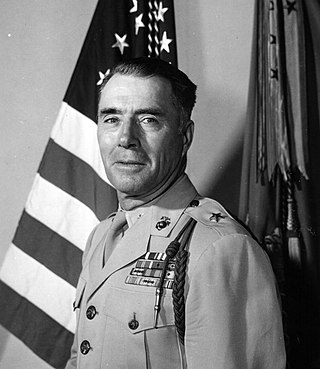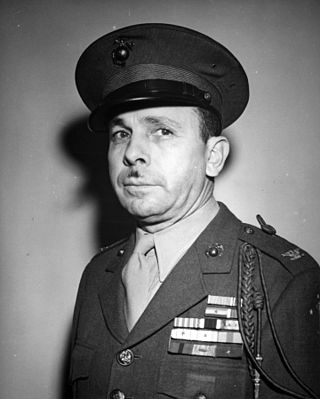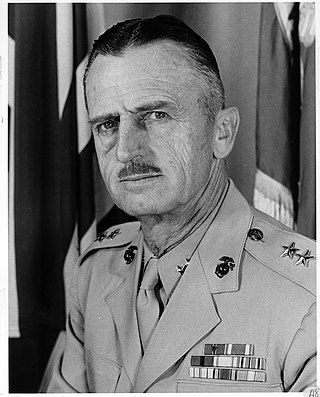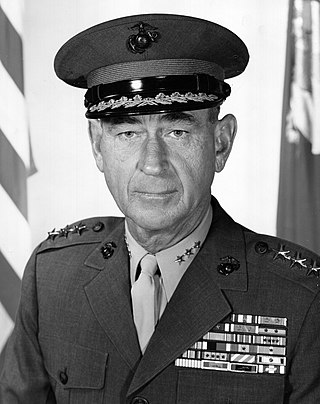
LeRoy Philip Hunt was a highly decorated officer in the United States Marine Corps with the rank of general. A veteran of World War I, he was decorated with the Navy Cross and Army Distinguished Service Cross, the United States military's two second-highest decorations awarded for valor in combat.

Caleb Thayer "Zeke" Bailey was a decorated officer and naval aviator in the United States Marine Corps with the rank of brigadier general. An excellent athlete while at the University of Maryland, he distinguished himself as center in the UM Terrapins football team and following his commissioning in the Marine, he also excelled in Quantico Marines Devil Dogs football.

William John Whaling was a highly decorated Major general in the United States Marine Corps and an expert in jungle warfare during the Pacific War. He also competed as a sport shooter in the 1924 Summer Olympics, where he finished in 12th place in the 25 m rapid fire pistol competition.

Clayton Barney Vogel was a United States Marine Corps officer with the rank of major general who served in a variety of capacities from 1902 until 1946. He is best known for his support of the Navajo code talker program.

William Jennings Wallace was a highly decorated aviation officer of the United States Marine Corps with the rank of lieutenant general. He is most noted for his service as commanding officer of MAG-22 at Midway and MAG-23 at Guadalcanal and the Air Defense Command during the Battle of Okinawa.
Marine Air, West Coast (MarAirWest) was a United States Marine Corps aviation training and administrative command established on 22 January 1943, which was responsible for the administration, training and equipment of the Marine Aviation Units on the West Coast during World War II.

James Joseph Keating was a United States Marine Corps officer with the rank of brigadier general, who is most noted as commanding officer of the 3rd Battalion, 11th Marines during the Battle of Guadalcanal and later as officer in charge of the Intelligence Section, Headquarters Marine Corps.

Amor LeRoy Sims was a highly decorated officer of the United States Marine Corps with the rank of brigadier general, who is most noted as commanding officer of 7th Marine Regiment during World War II. He also served as chief of the Norfolk Police Department from 1949 to 1952.

Harold Ellett Rosecrans was a highly decorated officer of the United States Marine Corps with the rank of brigadier general, who commanded 2nd Battalion 5th Marines during the during the assault on Tulagi Island. He later commanded 17th Marine Regiment during Battle of Cape Gloucester.

William Wallace Davies was a decorated officer of the United States Marine Corps with the rank of major general. He is most noted as a pioneer in the development of the Marine Corps Landing craft. He later commanded the Troop Training Unit, Naval Amphibious Base Coronado.

Earl Cecil Long was a decorated officer in the United States Marine Corps who reached the rank of major general. During World War II, he served as commanding general of Service Command Fleet Marine Force, Pacific and later as commanding general of Marine Corps Recruit Depot San Diego.

William Putnam Battell was a mustang officer in the United States Marine Corps, who is most noted for his service as Quartermaster General of the Marine Corps between dates July 1, 1963 – March 1, 1965. He began his career as enlisted man and was commissioned later. During World War II, Battell served as Signal Supply Officer in the Pacific theater and was decorated for bravery.

Archie Franklin Howard was a decorated officer of the United States Marine Corps with the rank of major general who is most noted as commanding general, 6th Marine Division during the Chinese Civil War. He also served as Island Commander at Guadalcanal and later at New Georgia during World War II.

St. Julien Ravenel Marshall was officer in the United States Marine Corps with the rank of brigadier general. He distinguished himself as Intelligence officer (G-2) of V Amphibious Corps during World War II. Marshall also served with the group that established the Central Intelligence Agency after the war. His older brother was Major General Richard Marshall.

George Joseph O'Shea was a highly decorated officer in the United States Marine Corps with the rank of brigadier general. He was decorated with the Navy Cross, the United States military's second-highest decoration awarded for valor in combat, during Battle of Sapotillal in October 1927. O'Shea served in the Pacific theater during World War II and retired in 1952 as director of 1st Marine Corps Reserve District in Boston.

Joseph Charles Fegan Jr. was a highly decorated officer in the United States Marine Corps with the rank of lieutenant general. A son of Major General Joseph C. Fegan, he received several citations for bravery during three wars and completed his career as commanding general, Marine Corps Development and Education Command.

James Frederick Moriarty was a highly decorated officer in the United States Marine Corps with the rank of brigadier general. A veteran of World War I, he distinguished himself several times as a company officer with the 6th Machine Gun Battalion and received four awards of the Silver Star.

Archie Edward O'Neil was an officer in the United States Marine Corps with the rank of Brigadier general. He is most noted for his service as Commanding officer, 9th Defense Battalion during the Recapture of Guam in July 1944.

Hugh McJunkin Elwood was a highly decorated flying ace in the United States Marine Corps during World War II. A veteran of three conflicts, he remained in the Marines and reached the rank of lieutenant general. Elwood completed his career as deputy chief of staff in 1973 after 40 years of service.

Ralph Kaspar Rottet was a decorated officer and naval aviator in the United States Marine Corps with the rank of lieutenant general. A veteran of World War II, where he distinguished as commanding officer, Marine Aircraft Group 31, he later rose to through the ranks and completed his career as Deputy Chief of Staff for Plans and Programs at Headquarters Marine Corps in 1968.










































